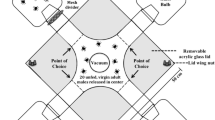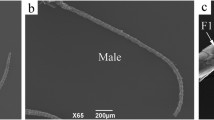Abstract
The foreleg claw sensilla of male D. variabilis, D. andersoni and A. americanum ticks indlude the receptors that perceive the female contact mounting sex pheromone (MSP). In all three tick species, the foreleg claw sensilla comprise six anteriorly-directed setae arranged in three symmetrical pairs, two each on the opposite sides of the apotele of the claw and one on the ventral side. Morphological study and behavioral bioassays of these setae revealed that only the dorsal and middle (=lateral) pairs of claw sensilla are mechanogustatory. While the ventral pair are strictly mechanoreceptors. The dorsal and middle sensory setae exhibit a single pore-like structure located at or near their tip, a feature characteristic of mechanogustatory sensilla. These setae are similar to those found on the palps that are believed to function as pheromone receptors. In all three tick species, male mounting and postmounting behaviors were suppressed only when the dorsal and middle pairs of claw sensilla were ablated or covered with gelatin; normal behavior was restored when the gelatin was removed. Doscresponse bioassays were conducted with D. variabilis males to authenticate the results of the gelatin tests. The results of these bioassays demonstrated that the gelatin coat was impervious to the pheromone. The characteristics of the ixodid tick mating system that distinguish it from mating processes in other arthropods are discussed.
Similar content being viewed by others
References
Allan, S.A., Phillips, J.S., Taylor, D. and Sonenshine, D. E., 1988. Genital sex pheromones of ixodid ticks: evidence for the role of fatty acids from the anterior reproductive tract in mating of Dermacentor variabilis and Dermacentor andersoni. J. Insect Physiol., 34(4): 315–323.
Allan, S.A., Phillips, J.S. and Sonenshine, D.E., 1989. Species recognition clicited by differences in composition of the genital sex pheromone in Dermacentor variabilis and D. andersoni (Acari: Ixodidae). J. Med. Entomol. 26(6): 539–546.
Allan, S.A., Phillips, J.S. and Sonenshine, D. E., 1991. Amblyomma americanum and Amblyomma maculatum (Acari: Ixodidae). Role of genital sex pheromones. Exp. Appl. Acarol., 11: 9–21.
Axtell, R.C., 1974. Tarsal sensory receptors of ticks. In Proceedings of the 4th International Congress of Acarology (ed. Piffl, E.), pp. 669–672. Akademaiai Kiado, Budapest.
Balashov, Yu.S., Ivanov, V.P. and Ignatiev, A.M. 1976. Fine structure and function of the palpal receptor organ in ixodid ticks (Acarina: Ixodoidea). Zool. Zh., 55: 1134–1143.
Carlson, D.A., Langley, P.A. and Huyton, P. 1978. Sex pheromone of the Tsetse Fly: isolation, identification, and synthesis of contact aphrodisiacs. Science 201: 750–753.
Chu-Wang, I.W. and Axtell, R.C., 1973. Comparative fine structure of the claw sensilla of a soft tick, Argas (Persicargas) arboreus Kaiser, Hoogstraal, and Kohls, and a hard tick. Amblyomma americanum (L.). J. Parasitol. 59(3): 545–555.
Conover, W.J., 1980. Practical Nonparametric Statistics, 2nd edn. 493 pp. John Wiley and Sons, New York.
Elizarov, Yu.A., 1963. Insect and tick chemoreception: electrophysiologic study of the chemoreception of Ixodidac. Vestn. mosk. Univ., Ser. 6. Biol. Pochvolved., 18(6), 16–24.
Foelix, R.F., 1982. Biology of Spiders, 306 pp. Harvard University Press, Cambridge, Massachusetts.
Foelix, R.F., 1985. Mechano- and chemoreceptive sensilla. In: Neurobiology of Arachnids (ed. Barth, F.G.), pp. 118–137. Springer-Verlag, New York.
Foelix, R.F. and Chu-Wang, I.W., 1972. Fine structural analysis of palpal receptors in the tick Amblyomma americanum (L.). Z. Zellforsch. Mikrosk. Anat., 129: 548–560.
Gothe, R. and Kraiss, A., 1982. Zur lokalisation der Pheromonemission und-perzeption bei Argas (Persicargas) walkerae Kaiser und Hoogstraal, 1969. Zbl. Vet. Med. B., 29: 573–582.
Graf, J.F., 1975. Ecologie et ethologie d'Ixodes ricinus L. en Suisse. Acarologia, 17: 436–441.
Guerin, P.M., Steullet, P., Kröber, T., Grenacher, S., Diehl, P.A., Vlimant, M., de Bruyne, M., Cordas, T., Falk-Vairant, J., Kuhnert, F. and Lösel, P.M., 1992. The chemical ecology of ticks at the host-vector interface. In First International Conference on Tick-Borne Pathogens at the Host-Vector Interface: An Agenda for Research. (eds. Munderloh, U.G. and Kurtti, T.J.) pp. 314–323. University of Minnesota College of Agriculture, Department of Entomology and Minnesota Extension Service.
Haggart, D.A. and Davis, E.E., 1981. Neurons sensitive to 2,6-dichlorophenol on the tarsi of the tick Amblyomma americanum (Acari: Ixodidae). J. Med. Entomol., 18(3): 187–193.
Hamilton, J.G.C. and Sonenshine, D.E., 1988. Evidence for the occurrence of mounting sex pheromone on body surface of female Dermacentor variabilis (Say) and Dermacentor andersoni Stiles (Acari: Ixodidae). J. Chem. Ecol., 14(1): 401–410.
Hamilton, J.G.C., Sonenshine, D.E. and Lusby, W.R., 1989. Cholesteryl oleate: mounting sex pheromone of the hard tick Dermacentor variabilis (Say) (Acari: Ixodidae). J. Insect Physiol., 35(11): 873–879.
Hess, E. and Vlimant, M., 1982. The tarsal sensory system of Amblyomma variegatum Fabricius (Ixodidae, Metastriata) I. Wall pore and terminal pore sensilla. Revue Suisse Zool., 89(3): 713–729.
Hess, E. and Vlimant, M., 1983. The tarsal sensory system of Amblyomma variegatum Fabricius (Ixodidae, Metastriata) III. Mapping of sensory hairs and evolution of the relative importance of sensory modalities during post-embryonic development. Revue Suisse Zool., 90: 887–897.
Hess, E. and Vlimant, M., 1986. Leg sense organs in ticks. In Morphology, Physiology and Behavioral Biology of Ticks (eds. Sauer, J.R. and Hair, J.A.), pp. 361–390. Halstead Press, New York.
Huyton, P.M., Langley, P.A., Carlson, D.A. and Coates, T.W., 1980. The role of sex pheromones in initiation of copulatory behavior by male tsetse flies, Glossina morsitans morsitans. Physiol. Entomol. 5: 243–252.
Ivanov, V.P. and Leonovich, S.S., 1983. Sensory organs. In Atlas of Ixodid Tick Ultrastructure (ed. Balashov, Yu.S.). pp. 191–220. Nauka Publishers, Leningrad (English translation, Entomological Society of America Special Publication).
Lang, J.T., 1977. Contact sex pheromone in the mosquito Culiseta inornata (Diptera: Culicidae). J. Med. Entomol., 14(4): 448–454.
Lang, J.T. and Foster, W.A., 1976. Is there a female sex pheromone in the mosquito Culiseta inornata?. Environ. Entomol., 5: 1109–1115.
Langley, P.A., Coates, T.W. and Carlson, D.A., 1982. Sex recognition pheromone in the tsetse fly Glossina pallidipes Austen. Experientia, 38: 473–475.
Langley, P.A. and Hall, M.J.R., 1984. Aspects of the regulation of mating behavior in tsetse. Insect Sci. Appl., 5: 351–355.
Langley, P.A., Pimley, R.W. and Carlson, D.A., 1975. Sex recognition pheromone in the tsetse fly Glossina morsitans. Nature, 254: 51–53.
Leahy, M.G., 1979. Pheromones of argasid ticks. In Recent Advances in Acarology, Vol. II (ed. Rodriguez, J.G.), pp. 297–308. Academic Press, Inc., New York.
Leahy, M.G., Sternberg, S., Mango, C.K.A. and Galun, R., 1975. An assembly pheromone and its perception in the tick Ornithodoros moubata (Murray) (Acari; Argasidae). J. Med. Entomol., 12: 284–287.
Matthews, R.W. and Matthews, J.R., 1978. Insect Behavior, pp. 507. John Wiley and Sons, New York
Mohamed, F.S.A., Khalil, G.M., Marzouk, A.S. and Roshdy, M.A., 1990. Sex pheromone regulation of mating behavior in the tick Ornithodoros (Ornithodoros) savignyi (Audouin) (Acari: Argasidae). J. Med. Entomol., 27(3): 288–294.
Muhammed, S., Butler, J.F. and Carlson, T.A., 1975. Stable fly sex attractant and mating pheromones found in female body hydrocarbons. J. Chem. Ecol., 1: 387–398.
Nijhout, H.F. and Craig, G.B.Jr., 1971. Reproductive isolation in Stegomyia mosquitoes. III. Evidence for a sexual pheromone. Entomol. Exp. Appl., 14: 399–412.
Schlein, Y., Galun, R. and Ben-Eliahu, M.N., 1981. Receptors of sex pheromones and abstinons in Musca domestica and Glossina morsitans. J. Chem. Ecol., 7(2): 291–303.
Schlein, Y. and Gunders, A.E., 1981. Pheromone of Ornithodoros spp. (Argasidae) in the coxal fluid of female ticks. Parasitology, 82: 467–471.
Sokal, R.R. and Rohlf, F.J., 1981. Biometry: The Principles and Practices of Statistics in Biological Research, 2nd edn, 859 pp. W.H. Freeman and Company, San Francisco.
Sonenshine, D.E., 1985. Pheromones and other semiochemicals of the Acari. Ann. Rev. Entomol., 30: 1–28.
Sonenshine, D.E., Hamilton, J.G., Phillips, J.S. and Lusby, W.R., 1991. Mounting sex pheromone: its role in regulation of mate recognition in the Ixodidae. In Modern Acarology, Vol. I. (eds. Dusbábek, F. and Bukva, V.). pp. 69–78. Academia, Prague and SPB Academic Publishing, The Hague.
Sonenshine, D.E., Homsher, P.J., Carson, K.A. and Wang, V.D., 1984. Evidence of the role of the cheliceral digits in the perception of genital sex pheromone during mating in the American dog tick, Dermacentor variabilis (Acari; Ixodidae). J. Med. Entomol., 21(3): 296–306.
Sonenshine, D.E., Khalil, G.M., Homsher, P.J. and Mason, S.N., 1982. Dermacentor variabilis and Dermacentor andersoni: genital sex pheromones. Exp. Parasitol., 54: 317–330.
Sonenshine, D.E., Silverstein, R.M., Brossut, R., Davis, E.E., Taylor, D., Carson, K.A., Homsher, P.J. and Wang, V.B., 1985. Genital sex pheromones of ixodid ticks: 1. Evidence of occurrence in anterior reproductive tract of American dog tick, Dermacentor variabilis (Say) (Acari: Ixodidae). J. Chem. Ecol., 11(12): 1669–1694.
Sonenshine, D.E., Silverstein, R.M., Plummer, E., West, J.R. and McCullough, T., 1976. 2,6-dichlorophenol, the sex pheromone of the Rocky Mountain wood tick, Dermacentor andersoni Stiles and the American dog tick, Dermacentor variabilis (Say). J. Chem. Ecol., 2(2): 201–209.
Sonnet, P.E., Uebel, E.C. and Miller, R.W., 1975. Sex pheromone of the face fly and compounds influencing pheromone activity. Environ. Entomol., 4: 761–764.
Taylor, D., Phillips, J.S., Sonenshine, D.E. and Hanson, F.E., 1991. Ecdysteroids as a component of the genital sex pheromone in two species of hard ticks, Dermacentor variabilis and Dermacentor andersoni (Acari: Ixodidae). Exp. Appl. Acarol., 12: 275–296.
Tobin, E.N. and Stoffolano, J.G.Jr., 1973. The courtship of Musca species found in North America. 2. The face fly, Musca autumnalis, and a comparison. Ann. Entomol. Soc. Amer., 66: 1329–1334.
Uebel, E.C., Schwarz, M., Miller, R.W. and Menzer, R.E., 1978. Mating stimulant pheromone and cuticular lipid constituents of Fannia femoralis (Stein) (Diptera: Muscidae). J. Chem. Ecol., 4(1): 83–93.
Uebel, E.C., Sonnet, P.E., Bierl, B.A. and Miller, R.W., 1975a. Sex pheromone of the stable fly: isolation and preliminary identification of compounds that induce mating strike behavior. J. Chem. Ecol., 1(3): 377–385.
Uebel, E.C., Sonnet, P.E., Menzer, R.E., Miller, R.W. and Lusby, W.R., 1977. Mating-stimulant pheromone and cuticular lipid constituents of the little house fly, Fannia canicularis (L.). J. Chem. Ecol., 3(3): 269–278.
Uebel, E.C., Sonnet, P.E., Miller, R.W. and Beroza, M., 1975b. Sex pheromone of the face fly, Musca autumnalis De Geer (Diptera: Muscidae). J. Chem. Ecol., 1(2): 195–202.
Waladde, S.M., 1976. The sensory nervous system of the adult cattle tick Boophilus microplus (Canestrini) Ixodidae. Part I. Light microscopy. J. Aust. Ent. Soc., 15: 379–387.
Waladde, S.M., 1977. The sensory nervous system of the adult cattle tick Boophilus microplus (Canestrini) Ixodidae. Part II. Scanning electron microscopy. J. Aust. Ent. Soc., 16: 73–79.
Waladde, S.M., 1978. A study of the structure and physiology of certain sensory receptors of the adult cattle tick Boophilus microplus (Canestrini) Ixodidac. PhD thesis, University of Queensland, Australia. In Physiology of Ticks (eds. Obenchain, F.D. and Galun, R.), pp. 99–101. Pergamon Press, Oxford.
Waladde, S.M., 1982. Tip-recording from ixodid tick olfactory sensilla: responses to tick related odours. J. Comp. Physiol. 148: 411–418.
Waladde, S.M. and Rice, M.J., 1982. The sensory basis of tick feeding behavior. In Physiology of Ticks (eds. Obenchain, F.D. and Galun, R.), pp. 71–118. Pergamon Press, Oxford.
Zolotarev, E.Kh. and Elizarov, Yu.A., 1964. Study of chemoreception in insects and mites. Characteristic of the function of chemoreceptors in Hyalomma asiaticum under the action of repellents. Zool. Zh., 43: 549–559.
Zolotarev, E.Kh. and Sinitzina, E.E., 1965. Chemoreceptive organs of the foreleg of ixodid ticks. Vestn. Mosk. Univ., 20: 17–25.
Author information
Authors and Affiliations
Rights and permissions
About this article
Cite this article
Phillips, J.S., Sonenshine, D.E. Role of the male claw sensilla in perception of female mounting sex pheromone in Dermacentor variabilis, Dermacentor andersoni and Amblyomma americanum . Exp Appl Acarol 17, 631–653 (1993). https://doi.org/10.1007/BF00058504
Accepted:
Issue Date:
DOI: https://doi.org/10.1007/BF00058504




